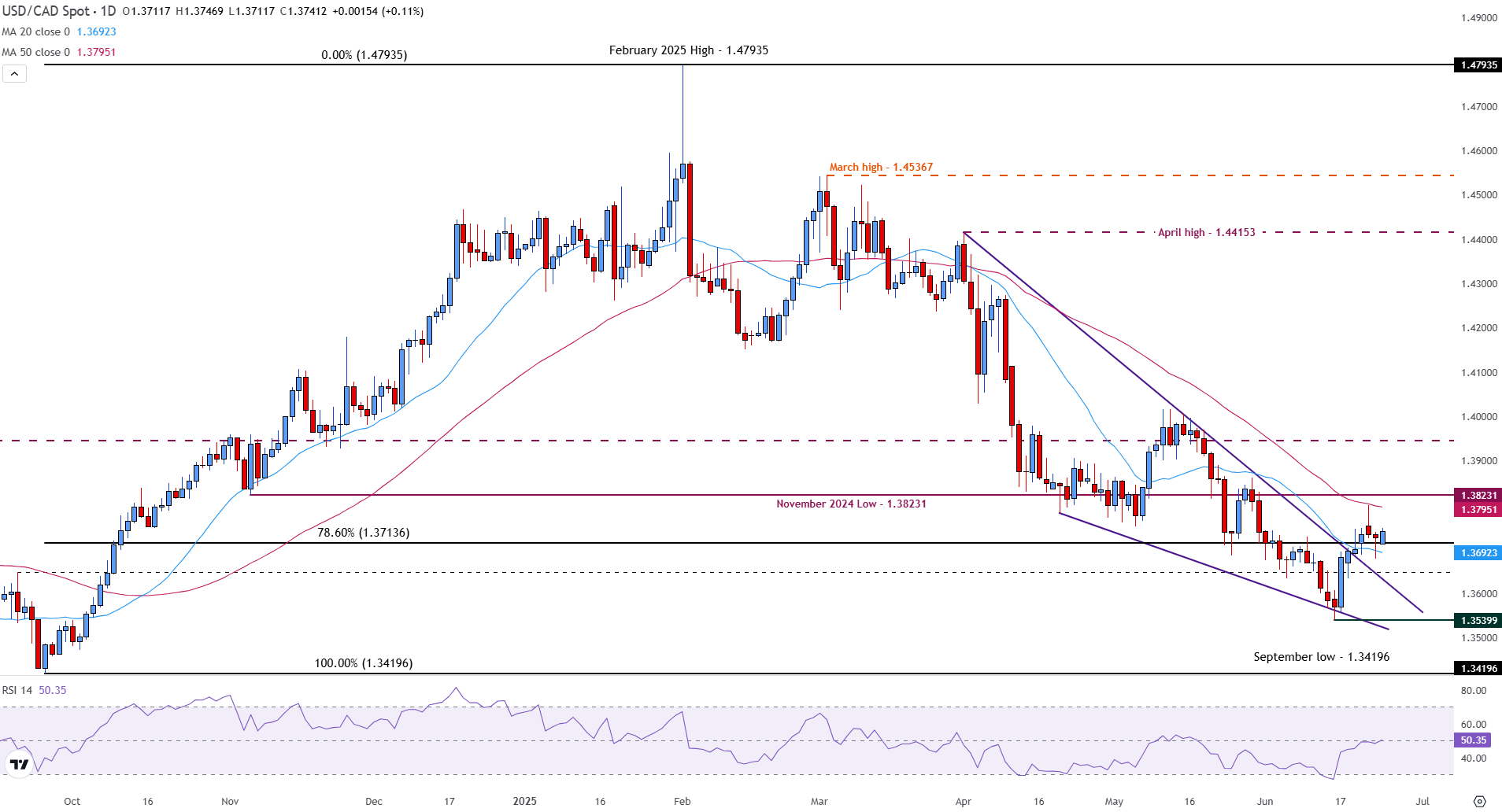- The USD/CAD advances as markets expect more clues from the president of the FED, Powell.
- New housing sales data is expected in the US for May at 14:00 GMT to provide additional information about the current health market in the US.
- The Loonie pair is still vulnerable to the feeling of risk and developments in the United States, which could provide more information about interest rates expectations.
The Canadian dollar (CAD) is weakening against the US dollar (USD) on Wednesday, while the currency pair tries to free itself from a consolidation phase.
With the USD/CAD quoting about 1,3750 at the time of writing, the publication of new housing sales data in the US for May and the testimony of the president of the Federal Reserve (Fed), Jerome Powell, are at the Center for Attention.
The US Census Office will publish its latest figures on new housing sales at 14:00 GMT, which reflect the number of single -family homes sold, regardless of their stage in the construction process. 690,000 units are expected to be sold in May, and market participants will also pay attention to the monthly percentage change.
With the sales of new homes in April, increasing drastically to 743,000 before the implementation of tariffs, the May report could provide a clearer image of how the construction and housing industry is working under current conditions.
At the same time, the president of the FED, Jerome Powell, will testify to the US Senate Committee on Banking, Housing and Urban Affairs. This is the second and last day of the audience of the semiannual monetary report, where Powell will continue to be interrogated about inflation, interest rates and the general health of the US economy.
This audience is particularly important, since it could provide valuable knowledge about future Federal Reserve plans for interest rates.
Investors will carefully analyze Powell’s comments for signals on inflation trends, economic growth and how Fed could adjust interest rates in the coming months.
Technical Analysis of the USD/CAD
The USD/CAD is currently consolidating around level 1.3740, slightly above the fibonacci setback of 78.6% of the increase from September to February in 1,3713.
The recent price action indicates a rupture of a descending wedge pattern, suggesting a possible change in momentum. However, the PAR faces a strong resistance near the single mobile average (SMA) of 50 days in 1,3795 and the minimum of November 2024 in 1,3823. These levels will be critical to determine if the torque can maintain a bull reversal.

Meanwhile, the relative force index (RSI) is about 50 in the daily chart, indicating a neutral momentum and a clear lack of direction.
A decisive movement above the resistance zone could open the road to the maximum of April in 1,4415, while a ruling in maintaining the current support in the fibonacci setback of 78.6% could lead to the pair back to the minimum of June 16 in 1,3539 or even the minimum of September in 1,3419.
US dollar FAQS
The US dollar (USD) is the official currency of the United States of America, and the “de facto” currency of a significant number of other countries where it is in circulation along with local tickets. According to data from 2022, it is the most negotiated currency in the world, with more than 88% of all global currency change operations, which is equivalent to an average of 6.6 billion dollars in daily transactions. After World War II, the USD took over the pound sterling as a world reserve currency.
The most important individual factor that influences the value of the US dollar is monetary policy, which is determined by the Federal Reserve (FED). The Fed has two mandates: to achieve price stability (control inflation) and promote full employment. Its main tool to achieve these two objectives is to adjust interest rates. When prices rise too quickly and inflation exceeds the 2% objective set by the Fed, it rises the types, which favors the price of the dollar. When inflation falls below 2% or the unemployment rate is too high, the Fed can lower interest rates, which weighs on the dollar.
In extreme situations, the Federal Reserve can also print more dollars and promulgate quantitative flexibility (QE). The QE is the process by which the Fed substantially increases the flow of credit in a stuck financial system. It is an unconventional policy measure that is used when the credit has been exhausted because banks do not lend each other (for fear of the default of the counterparts). It is the last resort when it is unlikely that a simple decrease in interest rates will achieve the necessary result. It was the weapon chosen by the Fed to combat the contraction of the credit that occurred during the great financial crisis of 2008. It is that the Fed prints more dollars and uses them to buy bonds of the US government, mainly of financial institutions. Which usually leads to a weakening of the US dollar.
The quantitative hardening (QT) is the reverse process for which the Federal Reserve stops buying bonds from financial institutions and does not reinvote the capital of the wallet values that overcome in new purchases. It is usually positive for the US dollar.
Source: Fx Street
I am Joshua Winder, a senior-level journalist and editor at World Stock Market. I specialize in covering news related to the stock market and economic trends. With more than 8 years of experience in this field, I have become an expert in financial reporting.







